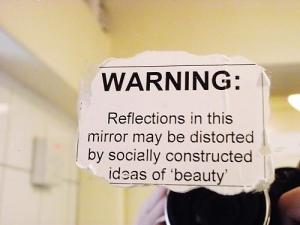
We humans have been looking in the mirror for a long time, constructing selves that we project out to the world. It’s an especially developed characteristic of our species – the particular ways we fake being somebody important – like male peacocks and their crazy tails.
As I’ve been focussed on studying Hakuin Zenji this past year, one of the striking things I’ve noticed about him is how modern he was in just this way. The spread and availability of wood-block printing, the big technological breakthrough of his time, he used like a Tweet master, telling tall and wild stories, playing his audience, using exaggerated speech, presenting himself as a caricature of a Zen master in order to spread the truth of the buddhadharma that he discovered through his many awakenings.
Hakuin was a very early adopter in what has become a necessary function of our modern social media mania. In yesterday’s New York Times, Ruth Whippman has an excellent reflection piece about this: Everything Is for Sale Now. Even Us. Whippman notes that she, like many of us, “… Ambivalently ‘maintain[s] a presence on social media,’ attempting to sell a semi-fictional, much more appealing version of myself in the vain hope that this might somehow help me sell some actual stuff at some unspecified future time.”
Hakuin, though, didn’t seem to have been ambivalent at all. Indeed, he seems to have loved the show. Now, though, this capacity to project a social-media self construct, is more and more closely linked with livelihood.
“When we think ‘gig economy,’ we tend to picture,” writes Whippman, “an Uber driver or a TaskRabbit tasker rather than a lawyer or a doctor, but in reality, this scrappy economic model — grubbing around for work, all big dreams and bad health insurance — will soon catch up with the bulk of America’s middle class…. Being sold to can be socially awkward, for sure, but when it comes to corrosive self-doubt, being the seller is a thousand times worse. The constant curation of a salable self demanded by the new economy can be a special hellspring of anxiety.”
When we think “gig economy,” we probably also don’t think about Zen teachers, mindfulness instructors, or Tibetan lamas, but we’re all in this thing together. Not long ago, Henry David Thoreau wrote (so quaintly now),
“To do things ‘railroad fashion’ is now the byword; and it is worth the while to be warned so often and so sincerely by any power to get off its track. There is no stopping to read the riot act, no firing over the heads of the mob, in this case. We have constructed a fate, an Atropos, that never turns aside. (Let that be the name of your engine.)”
The train of the social-media self construct has and will continue to influence how the buddhadharma is presented and how teachers hustle their buddhadharma, how we deal with making a living. It is one big fat locomotive whirring down the track, encouraging inflation and even fictionalized bios as it whirs.Your teacher’s “monastic training” might be a long weekend at a motel in Vegas. Really. I am not making this up! Such wanton bio engorgement used to be a specialty of (mostly white) men, but now I also see women doing it too. And if our bios are inflated, then how about how the social-media self construct impacts who, what, and how we teach?
“This is the future,” writes Whippman, “and research suggests that it’s a rat race that is already taking a severe toll on our psyches. A 2017 study suggests that this trend toward increasingly market-driven human interaction is making us paranoid, jittery, self-critical and judgmental.”
Yeah! You think dharma teaching is just zenning away in the white cloud of the absolute until the next teacher dana comes in? As for me, I’m one of the lucky ones, able to live simply, and practice and teach full time, thanks to the Vine of Obstacles. Living the dream, indeed.
When I look around, though, especially at the younger generation, I see a lot of hustle and anxiety. Instead of a life focussed on practicing zazen, studying the ancients, offering the buddhadharma to a community, and playing in dharma arts, many modern dharma teachers are stressed out like Whippman:
“Like many modern workers, I find that only a small percentage of my job is now actually doing my job. The rest is performing a million acts of unpaid micro-labor that can easily add up to a full-time job in itself. Tweeting and sharing and schmoozing and blogging. Liking and commenting on others’ tweets and shares and schmoozes and blogs.”
What to do? One thing is to be like Hakuin and use the media rather than be used by it. That’s so easy to say, but so hard to practice. I often say to my wife that when I really retire, I’ll disconnect everything. She usually says something like, “Uh-huh,” and rolls her eyes.
Because there’s this:

Dōshō Port began practicing Zen in 1977 and now co-teaches with his wife, Tetsugan Zummach Osho. Dōshō also teaches with the Vine of Obstacles: Online Support for Zen Training, an internet-based Zen community. Dōshō received dharma transmission from Dainin Katagiri Rōshi and inka shōmei from James Myōun Ford Rōshi in the Harada-Yasutani lineage. He is the author of Keep Me In Your Heart a While: The Haunting Zen of Dainin Katagiri.











